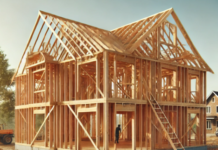Ever dreamed of building your own home, but worried your wallet might not stretch that far? You’re not alone! The idea of constructing a house from the ground up can be both exhilarating and terrifying, especially when you start crunching the numbers. But here’s the kicker: with some savvy planning and a few insider tricks, you can turn that dream into a reality without emptying your savings account.
In this guide, we’re gonna dive deep into the world of budget-friendly home construction. We’ll uncover the secrets that’ll help you build a home that’s not just affordable, but also a place you’ll love to call your own. From clever design hacks to money-saving construction techniques, we’ve got you covered. So, buckle up, future homeowners – it’s time to embark on a journey that’ll bring you one step closer to your dream home!
What You’ll Learn
- How to effectively plan and stick to a home construction budget
- Design strategies that maximize space while minimizing costs
- Cost-effective construction methods and materials
- Smart ways to prioritize features and upgrades
- Tips for managing finances throughout the building process
- Strategies for finding affordable land and navigating permits
By the time you finish this article, you’ll be armed with a toolkit of budget-friendly strategies that’ll make your home-building journey smoother and more affordable. Whether you’re a first-time builder or looking to cut costs on your next project, these tips and tricks will help you navigate the complex world of home construction without breaking the bank. Ready to turn that “someday” dream into a “right now” reality? Let’s dive in!
Planning Your Home Build Budget
Let’s face it – building a home isn’t exactly cheap. But with some careful planning and a bit of financial finesse, you can make it a whole lot more affordable. So, let’s roll up our sleeves and dig into the nitty-gritty of budget planning for your dream home.
Analyzing the Costs Involved in Building a Home
Building a home is like putting together a giant puzzle – there are a ton of pieces, and they all cost money. Here’s a quick breakdown of the major expenses you’ll need to factor in:
- Land costs: This can vary wildly depending on location, but it’s often a big chunk of your budget.
- Site preparation: Think clearing, grading, and getting utilities hooked up.
- Foundation: The literal groundwork for your home.
- Framing: The skeleton of your house.
- Exterior finishes: Siding, roofing, windows, and doors.
- Interior finishes: Drywall, flooring, cabinets, and all the pretty stuff.
- Mechanical systems: Plumbing, electrical, and HVAC.
- Labor costs: Unless you’re planning to build the whole thing yourself!
- Permits and fees: The necessary evil of bureaucracy.
Remember, these are just the broad strokes. There’ll be a lot of little expenses that pop up along the way. But don’t worry – we’ll talk about how to handle those curveballs later!
Understanding the Key Factors That Impact the Budget
Now, here’s where things get interesting. Your budget isn’t just a static number – it’s influenced by a whole bunch of factors. Some of the biggies include:
- Location: Building in the heart of the city? Prepare for your wallet to take a hit.
- Size: Bigger isn’t always better, especially when it comes to your bank account.
- Design complexity: Fancy features and unique architectural elements can send costs soaring.
- Materials: High-end finishes will cost you, but there are ways to get a luxe look for less.
- Timeline: Rushing the process often means paying a premium.
- Market conditions: The cost of materials and labor can fluctuate based on market trends.
Understanding these factors is like having a secret weapon in your budget-planning arsenal. It’ll help you make informed decisions about where to splurge and where to save.
Setting Realistic Financial Goals for the Construction Project
Alright, time for a reality check. We all want our dream home, but unless you’ve got a money tree in the backyard, you’ll need to set some realistic financial goals. Here’s how to do it:
- Start with your max budget: What’s the absolute most you can afford to spend?
- Build in a buffer: Trust me, you’ll thank yourself later. Aim for at least 10-20% of your total budget.
- Prioritize your must-haves: What features are non-negotiable? What can you live without?
- Get multiple quotes: Don’t just go with the first contractor you meet. Shop around!
- Be flexible: Sometimes, you gotta roll with the punches and adjust your plans.
Remember, setting realistic goals doesn’t mean settling for less. It means being smart about your choices so you can get the most bang for your buck. And speaking of smart choices…
Designing for Affordability
You know what they say – good design is worth its weight in gold. But when you’re building on a budget, your design choices can make or break your bank account. Let’s explore some savvy design strategies that’ll help you create a beautiful home without emptying your wallet.
Selecting a Simple and Efficient Floor Plan to Minimize Construction Costs
When it comes to affordable home building, sometimes less really is more. A simple, efficient floor plan can save you a bundle without sacrificing style or functionality. Here’s why:
- Fewer walls = less material and labor costs
- Simpler roof designs are cheaper to construct
- Rectangular shapes are generally more cost-effective than complex layouts
- Open floor plans can make a smaller home feel more spacious
But don’t worry – simple doesn’t have to mean boring! With some creative touches and smart design choices, you can turn a basic floor plan into a stunning home that’s uniquely yours.
Pro tip: Consider a two-story design. It often costs less per square foot than a sprawling single-story home, plus you’ll save on foundation and roofing costs.
Maximizing Space Utilization to Avoid Unnecessary Square Footage
Here’s a secret: you probably don’t need as much space as you think you do. One of the best ways to keep costs down is to make every square foot count. Try these space-saving tricks:
- Use built-ins for storage instead of large closets
- Create multi-functional spaces (like a home office that doubles as a guest room)
- Opt for an eat-in kitchen instead of a separate formal dining room
- Consider smaller, more efficient appliances
Remember, it’s not about how much space you have – it’s about how well you use it. A well-designed 1,500 square foot home can feel more comfortable and functional than a poorly planned 2,500 square foot McMansion.
Considering Future Expansions During the Initial Design Phase
Let’s talk about future-proofing your home. While you’re focused on keeping costs down now, it’s smart to think about potential expansions down the road. Here’s why:
- It’s often cheaper to plan for future additions now than to retrofit later
- You can rough-in plumbing and electrical for future bathrooms or additions
- Designing with expansion in mind can increase your home’s long-term value
Some ideas to consider:
- Unfinished basement or attic space that can be converted later
- Designing the roof to accommodate a future second story
- Leaving space for a future garage or sunroom
By thinking ahead, you’re not just building a home for today – you’re creating a space that can grow and change with your family’s needs. Now that’s what I call smart design!
Cost-Effective Construction Methods
Alright, let’s get our hands dirty! We’ve got the budget planned and a smart design in mind, but now it’s time to talk about how we’re actually gonna build this thing without breaking the bank. Ready to learn some tricks of the trade?
Exploring Economical Building Materials and Construction Techniques
Who says you need to spend a fortune on materials to build a great home? With a little creativity and know-how, you can find budget-friendly alternatives that’ll do the job just as well. Here are some ideas to get you started:
- Consider using prefab or modular components: These can be cheaper and faster to install than building everything from scratch.
- Look into alternative framing methods: Things like structural insulated panels (SIPs) or insulated concrete forms (ICFs) can save on labor and energy costs in the long run.
- Opt for engineered wood products: They’re often cheaper and more stable than solid wood.
- Don’t overlook recycled or reclaimed materials: They can add character to your home and be easy on your wallet.
Remember, it’s not just about the materials themselves, but how you use ’em. For instance, standard-sized materials often result in less waste and lower costs. And speaking of waste…
Tips for Reducing Labor Costs Without Compromising Quality
Labor can eat up a big chunk of your budget faster than you can say “home sweet home.” But don’t worry, there are ways to keep those costs in check:
- Be your own general contractor: If you’re up for it, this can save you a bundle. Just make sure you’re ready for the responsibility!
- DIY where you can: If you are up to the task, tackle some of the simpler tasks yourself, like painting or landscaping.
- Choose simpler designs: The less complicated your home’s design, the less time (and money) it’ll take to build.
- Schedule efficiently: Good planning can prevent costly delays and keep your crew working productively.
- Consider off-season construction: Builders might offer better rates during their slower months.
Just remember, cutting corners on skilled labor can cost you more in the long run. The goal is to be smart about where and how you spend on labor, not to skimp on quality.
Strategies for Saving on Foundation and Structural Expenses
The foundation might not be the sexiest part of your new home, but it’s crucial – both for your house’s stability and your budget. Here are some ways to keep costs down without compromising on quality:
- Choose a simple foundation design: A basic slab or crawl space is often cheaper than a full basement.
- Opt for a walkout basement on a sloped lot: This can reduce the amount of excavation needed.
- Consider alternative foundation systems: Things like pier and beam or frost-protected shallow foundations can be more cost-effective in some situations.
- Don’t overbuild: Work with an engineer to ensure your foundation is adequate without being excessive.
And when it comes to the structure itself:
- Stick to standard ceiling heights: Those vaulted ceilings might look nice, but they’ll cost ya.
- Use trusses instead of stick-framing for your roof: They’re often cheaper and faster to install.
- Optimize your floor plan: Aim for a design that minimizes the need for long-span beams or complex structural elements.
Remember, a solid foundation and structure are worth investing in – they’re literally what your home is built on. But with some smart choices, you can ensure they’re rock-solid without rocking your budget.
Budget-Friendly Features and Upgrades
Now, let’s talk about the fun stuff – all those features and upgrades that’ll make your house feel like a home. But hold your horses! Before you go crazy with fancy fixtures and high-end finishes, let’s explore some budget-friendly options that’ll give you the most bang for your buck.
Identifying Energy-Efficient Options to Save on Long-Term Utility Costs
Here’s a secret: sometimes spending a little more upfront can save you big time in the long run. Energy-efficient features are a perfect example. They might cost a bit more initially, but they’ll keep your utility bills in check for years to come. Some ideas to consider:
- Invest in good insulation: It’s like a cozy sweater for your house, keeping you warm in winter and cool in summer.
- Choose energy-efficient windows: They’ll help regulate your home’s temperature and reduce your HVAC costs.
- Install a programmable thermostat: It’s like having a personal energy-saving assistant.
- Opt for LED lighting: They use way less energy and last much longer than traditional bulbs.
- Consider solar panels: If your budget allows, they can significantly reduce your electricity costs over time.
Remember, the goal is to balance upfront costs with long-term savings. It’s all about playing the long game!
Maximizing Tax Credits and Rebates Through Sustainable Building Practices
Uncle Sam wants you to build green – so much so that he’s willing to give you some money back for doing it! Many sustainable building practices can qualify you for tax credits and rebates. Here’s how to cash in:
- Research federal, state, and local incentives for energy-efficient home features.
- Look into rebates offered by utility companies for energy-saving appliances.
- Consider certifications like ENERGY STAR or LEED – they can qualify you for additional incentives.
- Keep detailed records of your green upgrades for tax time.
Pro tip: These incentives change frequently, so make sure to check what’s currently available in your area before making any decisions.
Prioritizing Essential Features and Postponing Non-Essential Upgrades
I get it – you want your new home to have all the bells and whistles. But unless you’ve got money to burn, you’ll need to prioritize. Here’s how to decide what’s worth splurging on now and what can wait:
- Focus on the bones: Invest in good structural elements, insulation, and major systems first.
- Prioritize features that are hard to add later: Things like extra outlets or pre-wiring for home automation.
- Go for timeless over trendy: Choose classic finishes that won’t look dated in a few years.
- Consider your daily life: Splurge on features you’ll use every day, like a quality kitchen faucet or comfortable flooring.
- Plan for future upgrades: Leave space for that fancy kitchen island or home theater you’re dreaming of.
Remember, Rome wasn’t built in a day, and your perfect home doesn’t have to be either. It’s okay to start with the essentials and add luxuries over time as your budget allows.
Financial Management Throughout the Construction Process
Alright, let’s talk money, honey! Building a home is like riding a financial rollercoaster – there are ups, downs, and sometimes unexpected loops. But don’t worry, we’re gonna make sure you don’t lose your lunch (or your shirt) on this ride.
Tracking and Controlling Spending During Each Phase of the Build
Listen up, ’cause this is important: keeping tabs on your spending is crucial if you want to stay on budget. Here’s how to keep your finances in check throughout the build:
- Break it down: Divide your budget into phases (foundation, framing, finishing, etc.) and track spending for each.
- Use a spreadsheet or budgeting app: Trust me, your napkin math won’t cut it here.
- Keep all receipts: And I mean all of ’em. Even that $2 box of nails counts!
- Regular check-ins: Set aside time each week to review your spending and adjust as needed.
- Have a contingency fund: Aim for 10-20% of your total budget for those “oops” moments.
Remember, knowledge is power. The more aware you are of where your money’s going, the better equipped you’ll be to make smart financial decisions.
Tips for Obtaining Competitive Bids from Contractors and Suppliers
Ready to flex those negotiation muscles? Getting competitive bids can save you a bundle. Here’s how to do it like a pro:
- Get at least three bids for each major job or purchase.
- Be specific about what you want: The more detailed your request, the more accurate the bids will be.
- Don’t automatically go for the lowest bid: Sometimes, you get what you pay for.
- Ask about discounts: Bulk purchases or off-season work might score you a deal.
- Be willing to negotiate: A little haggling can go a long way.
Pro tip: Always get bids in writing and make sure they include all costs, including materials, labor, and any potential extras.
Managing Unexpected Expenses and Staying Within the Budget
Surprise! No, not the fun kind – I’m talking about those unexpected expenses that can pop up during a build. Here’s how to roll with the punches:
- Expect the unexpected: Build that contingency fund we talked about earlier.
- Prioritize your must-haves: Know what you’re willing to compromise on if push comes to shove.
- Look for cost-cutting alternatives: If one area goes over budget, find ways to save in others.
- Communicate with your team: Keep everyone in the loop about budget constraints.
- Be flexible: Sometimes, a change of plans can lead to creative solutions.
Remember, it’s okay if things don’t go exactly as planned. The key is to stay calm, be flexible, and keep your eye on the prize – your beautiful new home!
Land Acquisition and Permitting Considerations
Now, let’s tackle the groundwork – literally! Finding the right piece of land and navigating the permitting process can be trickier than a game of Twister. But don’t worry, we’re gonna straighten it all out.
Strategies for Finding Affordable Land Suitable for Construction
Hunting for the perfect plot doesn’t have to cost an arm and a leg. Here are some savvy strategies to help you find affordable land:
- Look beyond the obvious: Sometimes, hidden gems are tucked away in unexpected places.
- Consider rural areas: They’re often cheaper than city lots, but make sure utilities are available.
- Check for foreclosures or tax sales: You might snag a deal, but do your homework first!
- Network: Let friends, family, and colleagues know you’re in the market. Word of mouth can work wonders.
- Be patient: The right piece of land at the right price might take time to find.
Remember, cheaper isn’t always better. Make sure the land is suitable for building and won’t require expensive site work before you sign on the dotted line.
Understanding the Costs Associated with Obtaining Necessary Permits
Ah, permits – the necessary evil of the construction world. They might not be fun, but they’re crucial. Here’s what you need to know:
- Research local requirements: Permit costs and processes vary widely by location.
- Budget for it: Permit fees can add up, so factor them into your overall budget.
- Consider hiring a pro: Sometimes, paying an expert to handle permits can save you time and headaches.
- Plan ahead: The permitting process can take weeks or even months. Start early!
Pro tip: Be nice to your local permit office staff. A little kindness can go a long way in smoothing the process.
Ensuring Compliance with Regulations While Minimizing Expenses
Playing by the rules doesn’t have to break the bank. Here’s how to stay compliant without overspending:
- Do your homework: Understanding local codes can help you avoid costly mistakes.
- Consider an experienced local architect or builder: They’ll know the ins and outs of local regulations.
- Plan carefully: Changes mid-construction can lead to expensive re-inspections.
- Be present for inspections: This can help you address any issues on the spot.
- Don’t cut corners: Trying to skirt regulations can lead to hefty fines or even having to redo work.
Remember, compliance isn’t just about avoiding fines – it’s about ensuring your home is safe and built to last. And at the end of the day, isn’t that what we all want?
Conclusion
Whew! We’ve covered a lot of ground, haven’t we? From crunching numbers to picking out energy-efficient lightbulbs, building a home on a budget is quite the adventure. But here’s the thing – it’s totally doable. With some smart planning, savvy decision-making, and a dash of creativity, you can build a home that’s both affordable and awesome.
Let’s recap some of the key takeaways:
- Plan your budget meticulously and stick to it like glue.
- Design with efficiency in mind – every square foot counts!
- Don’t be afraid to get your hands dirty with some DIY work.
- Prioritize energy efficiency for long-term savings.
- Stay flexible and ready to problem-solve when unexpected costs pop up.
- Do your homework on land acquisition and permitting to avoid costly surprises.
Remember, building a home on a budget isn’t about cutting corners – it’s about making smart choices that align with your financial goals and lifestyle needs. It might take a bit more effort and creativity, but the payoff is worth it. Just imagine walking through the front door of your very own home, knowing you built it without breaking the bank. Now that’s something to be proud of!
So, future homeowners, are you ready to turn that dream into a reality? With these budget-friendly secrets up your sleeve, you’re well on your way to building a home that’s not just affordable, but truly yours. Now go forth and build wisely!
FAQs
To wrap things up, let’s address some common questions about building a home on a budget:
Q: How much can I really save by building my own home instead of buying?
A: The savings can be significant, potentially up to 15-25% of the home’s value. However, it depends on factors like your location, the current real estate market, and how much work you’re willing to do yourself. Remember, the biggest savings often come from being your own general contractor, but that also comes with the most responsibility.
Q: Is it cheaper to build a one-story or two-story home?
A: Generally, two-story homes are more cost-effective per square foot. They require less foundation and roofing, which are expensive components of home building. However, the best choice depends on your specific needs and lot constraints.
Q: How can I save on kitchen and bathroom costs without sacrificing quality?
A: Focus on layout efficiency to reduce plumbing costs. Choose mid-grade appliances and fixtures – they often perform just as well as high-end options. Consider alternatives like quartz instead of marble for countertops. And don’t underestimate the power of good lighting to make a space feel luxurious!
Q: Are there any areas where I shouldn’t try to cut costs?
A: Absolutely. Don’t skimp on structural elements, insulation, or major systems like electrical and plumbing. These are crucial for your home’s safety, efficiency, and long-term value. It’s often worth investing a bit more in these areas to avoid costly repairs down the line.
Q: How do I avoid going over budget during the build?
A: Stay vigilant with your spending tracking, build in a contingency fund of at least 10%, and be prepared to make trade-offs if unexpected costs arise. Communication is key – keep all your contractors and suppliers informed about your budget constraints.
Remember, building a home on a budget is as much about smart planning and decision-making as it is about finding the best deals. With the right approach, you can create a beautiful, comfortable home that doesn’t empty your bank account. Happy building!
Key Takeaways
Before we wrap up, let’s highlight the most important points to remember when building your home on a budget:
- Thorough planning is crucial: A well-thought-out budget and design can save you thousands.
- Simplicity is your friend: Simple designs are often more cost-effective and easier to build.
- Energy efficiency pays off: Investing in energy-efficient features can lead to significant long-term savings.
- Be flexible: Be prepared to make adjustments as you go to stay within your budget.
- DIY where possible: Taking on some tasks yourself can lead to substantial savings.
- Don’t neglect the essentials: Prioritize structural integrity and major systems over aesthetic upgrades.
- Research is key: From finding affordable land to understanding local building codes, knowledge is power.
- Communication is critical: Keep open lines of communication with all parties involved in your build.
- Plan for the future: Consider potential future needs in your initial design to avoid costly renovations later.
- Enjoy the process: Building your own home is a unique and rewarding experience. Embrace the journey!
With these tips and strategies in mind, you’re well-equipped to embark on your budget-friendly home building adventure. Remember, every decision you make is a step closer to your dream home. Good luck, and happy building!



























